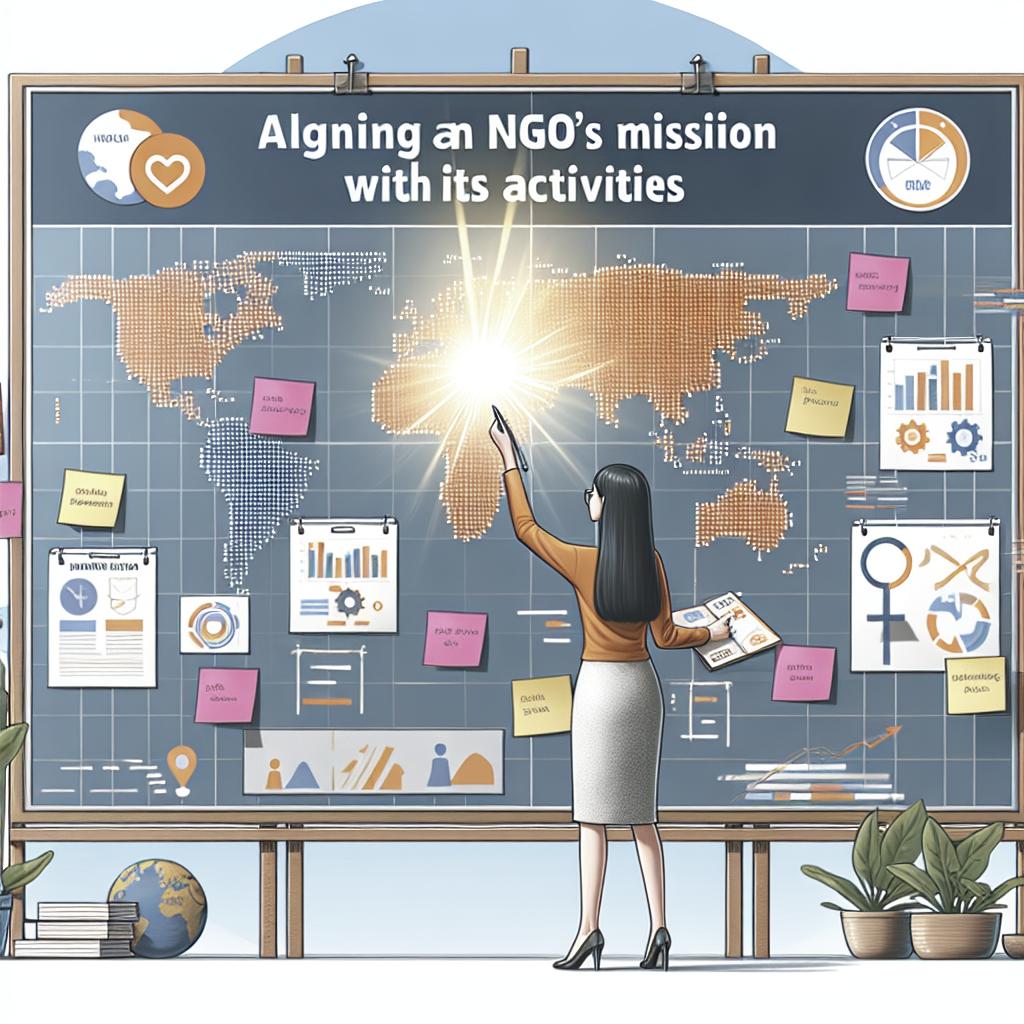“`html
How to Align an NGO’s Mission with Its Activities
For an NGO, aligning its mission with its activities is crucial in maintaining credibility, achieving long-term impact, and ensuring the effective use of resources. This process requires strategic planning, continuous evaluation, and adaptability. In this article, we will explore how NGOs can ensure their activities align with their mission statements, highlighting the significance of strategic planning, community involvement, accountability, and innovation. By the end of this guide, you’ll have a clearer understanding of aligning objectives with actions to maximize an NGO’s potential for societal impact.
1: Understanding the Mission Statement
The mission statement is the foundation upon which an NGO builds its identity and operational framework. It articulates the core purpose of the organization, indicating what it seeks to achieve in the world. Crafting a clear and compelling mission statement is the first step in aligning activities with the organization’s overarching goals.
Clarity in a mission statement provides direction and serves as a benchmark for decision-making. It ensures that every initiative or project undertaken by the NGO is scrutinized for alignment with its core objectives. This helps in maintaining focus and prevents mission drift, a common pitfall where an organization strays away from its intended purpose due to external pressures or internal disorganization.
2: Strategic Planning
Strategic planning plays a pivotal role in aligning an NGO’s activities with its mission. It involves setting long-term goals and identifying the necessary steps to achieve them. Strategic planning should include analysis of both internal capabilities and external environments to create a roadmap for success.
During this process, it is crucial to involve key stakeholders, such as board members, staff, and community representatives. This collaborative approach ensures that the plan is comprehensive and considers diverse perspectives. Regular reviews and updates of the strategic plan keep the organization responsive to changing circumstances while staying true to its mission.
3: Engaging with the Community
Community engagement is fundamental to aligning an NGO’s mission with its activities. By actively involving the communities they serve, NGOs can better understand the needs and expectations of their beneficiaries. This ensures that the initiatives an NGO embarks upon are relevant and impactful.
Feedback mechanisms, such as surveys and focus group discussions, are valuable tools in this process. These methods provide insights that help tailor activities to better serve the community’s needs. Additionally, fostering strong relationships with community members builds trust and enhances the NGO’s reputation and effectiveness.
4: Measuring and Evaluating Impact
To ensure that an NGO’s activities align with its mission, it’s essential to have robust mechanisms for measuring and evaluating impact. This involves setting clear, measurable objectives and regularly assessing the progress towards these goals. Evaluation frameworks should be incorporated into the planning phase itself, with predefined metrics to gauge effectiveness.
Through consistent evaluation, NGOs can identify successful initiatives and areas needing improvement. This iterative process fosters learning and adaptation, enabling the NGO to refine its strategies and enhance alignment with its mission over time.
5: Maintaining Accountability and Transparency
Accountability and transparency are integral to aligning an NGO’s mission with its activities. They foster trust among donors, beneficiaries, and other stakeholders, ensuring that resources are used effectively, and goals are met. This involves regular reporting and open communication about the organization’s operations, challenges, and successes.
Emphasizing accountability also means having the courage to admit failures and learn from them. Transparent practices like publishing annual reports and financial statements illustrate an NGO’s commitment to its mission and enhance its credibility.
6: Embracing Innovation and Flexibility
In a rapidly changing world, NGOs must be willing to innovate and adapt their strategies to continue aligning their activities with their mission. Embracing new technologies, methodologies, and partnerships can open new pathways to achieving organizational goals.
Flexibility in operations allows an NGO to pivot when needed, without compromising its core mission. This can involve adopting new practices inspired by successful models in the sector or experimenting with pilot projects that hold potential for greater impact. By staying agile, NGOs ensure they remain effective and relevant in fulfilling their mission.
Rate this article
We hope you found this guide useful. Please take a moment to rate your reading experience.
Thanks for your feedback
Your feedback is invaluable in helping us improve our content and provide better resources for our audience.
Tell us more
We would love to hear your thoughts on this topic. Share your experiences or any questions you may have regarding aligning NGO missions with activities.
More articles on Working Abroad
If you’re interested in exploring further topics, check out our collection of articles about working in global contexts and understanding international organizational frameworks.
Are you sure you want to delete your contribution?
Confirming this action will remove your contribution from our public discussion.
Are you sure you want to delete your reply?
Once deleted, you will not be able to recover your reply. Confirm your decision below.
Final Thoughts
| Key Component | Description |
|---|---|
| Understanding the Mission Statement | Establishing a clear, focused mission to guide organizational activities and avoid mission drift. |
| Strategic Planning | Creating a comprehensive roadmap involving stakeholders for aligning long-term goals with mission. |
| Engaging with the Community | Involving community feedback in planning to ensure initiatives are relevant and impactful. |
| Measuring and Evaluating Impact | Using metrics and regular assessments to refine activities and match them to mission objectives. |
| Maintaining Accountability and Transparency | Ensuring responsible resource usage and open communication to build trust. |
| Embracing Innovation and Flexibility | Adapting strategies and embracing new practices to stay relevant and effective. |
“` This HTML document offers a structured blog post that focuses on aligning an NGO’s mission with its activities. The use of various subheadings ensures a logical flow of information, tackling different aspects of the process while maintaining reader engagement.


